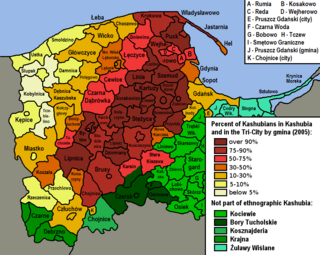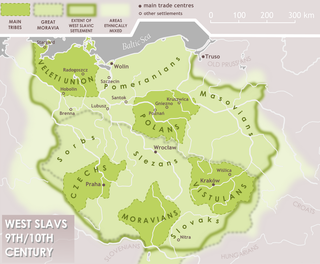Pomeranian is an adjective referring to the historical region of Pomerania, which is divided between Poland and Germany.
Pomeranian is an adjective referring to the historical region of Pomerania, which is divided between Poland and Germany.

The Kashubians, also known as Cassubians or Kashubs, are a Lechitic ethnic group native to the historical region of Pomerania, including its eastern part called Pomerelia, in north-central Poland. Their settlement area is referred to as Kashubia. They speak the Kashubian language, which is classified as a separate language closely related to Polish.

The Pomeranian language is in the Pomeranian group of Lechitic languages within the West Slavic languages.

Pomerania is a historical region on the southern shore of the Baltic Sea in Central Europe, split between Poland and Germany. The central and eastern part belongs to the West Pomeranian, Pomeranian and Kuyavian-Pomeranian voivodeships of Poland, while the western part belongs to the German states of Mecklenburg-Western Pomerania and Brandenburg.

Słupsk is a city with powiat rights located on the Słupia River in the Pomeranian Voivodeship in northern Poland, in the historical region of Pomerania or more specifically in its part known in contemporary Poland as Central Pomerania within the wider West Pomerania. According to Statistics Poland, it has a population of 88,835 inhabitants while occupying 43.15 square kilometres (16.66 sq mi), thus being one of the most densely populated cities in the country as of December 2021. In addition, the city is the administrative seat of Słupsk County and the rural Gmina Słupsk, despite belonging to neither, while until 1999 it was the capital of Słupsk Voivodeship.

Slovincian is the extinct language formerly spoken by the Slovincians living between lakes Gardno and Łebsko near Słupsk in Pomerania.

Slovincians, also known as Łeba Kashubians, is a near-extinct ethnic subgroup of the Kashubian people, who originated from the north western Kashubia, located in the Pomeranian Voivodeship, Poland, from the area around the lakes of Łebsko and Gardno. In the aftermath of World War II, Slovincians emigrated en masse to Germany, with the last families emigrating there in the 1980s. They originally spoke the Slovincian language, which went extinct in the early 20th century, as well as Kashubian, Polish, and German.

Pomerelia, also known as Eastern Pomerania, Vistula Pomerania, and also before World War II as Polish Pomerania, is a historical sub-region of Pomerania on the southern shore of the Baltic Sea in northern Poland.

The Pomeranians, first mentioned as such in the 10th century, were a West Slavic tribe, which from the 5th to the 6th centuries had settled at the shore of the Baltic Sea between the mouths of the Oder and Vistula Rivers. They spoke the Pomeranian language that belonged to the Lechitic languages, a branch of the West Slavic language family.

East Low German is a group of Low German dialects spoken in north-eastern Germany as well as by minorities in northern Poland. Together with West Low German dialects, it forms a dialect continuum of the Low German language. Before 1945, the dialect was spoken along the entire then-German-settled Baltic Coast from Mecklenburg, through Pomerania, West Prussia into certain villages of the East Prussian Klaipėda Region.

The Neumark, also known as the New March or as East Brandenburg, was a region of the Margraviate of Brandenburg and its successors located east of the Oder River in territory which became part of Poland in 1945.

The history of Pomerania starts shortly before 1000 AD, with ongoing conquests by newly arrived Polan rulers. Before that, the area was recorded nearly 2000 years ago as Germania, and in modern times Pomerania has been split between Germany and Poland. Its name comes from the Slavic po more, which means "land at the sea".

Gdańsk Pomerania, Kashubian: Gduńsczim Pòmòrzã, German: Danziger Pommern) is a geographical region within Pomerelia in northern and northwestern Poland, covering the bulk of Pomeranian Voivodeship.

Farther Pomerania, Hinder Pomerania, Rear Pomerania or Eastern Pomerania, is a subregion of the historic region of Pomerania in north-western Poland, mostly within the West Pomeranian Voivodeship, while its easternmost parts are within the Pomeranian Voivodeship.

The Province of Pomerania was a province of Prussia from 1815 to 1945. Pomerania was established as a province of the Kingdom of Prussia in 1815, an expansion of the older Brandenburg-Prussia province of Pomerania, and then became part of the German Empire in 1871. From 1918, Pomerania was a province of the Free State of Prussia until it was dissolved in 1945 following World War II, and its territory divided between Poland and Allied-occupied Germany. The city of Stettin was the provincial capital.

The Pomeranian Voivodeship was a unit of administrative division and local government in the Kingdom of Poland and the Polish–Lithuanian Commonwealth from 1454/1466 until the First partition of Poland in 1772. From 1613 the capital was at Skarszewy.

The Pomeranians are a German people native to the historical region of Pomerania. In modern times, its population inhabits Germany, including the state of Mecklenburg-Vorpommern. Nowadays there are about five million descendants of Germans in Brazil, a part of these Brazilians are of Pomeranian origin.

Pomerania during the Early Middle Ages covers the History of Pomerania from the 7th to the 11th centuries.
The Wolinians were a Lechitic tribe in Early Middle Age Pomerania. They were first mentioned as "Velunzani" with 70 civitates by the Bavarian Geographer, ca. 845. Associated with both the Veleti and the Pomeranians, they were based on the island of Wolin and the adjacent mainland. Compared to other tribes of these groups, the Wolinians' territory was relatively small but densely settled: in the 11th century, there was one settlement per four square kilometers. The Wolinians are described by Jan Maria Piskorski as the most powerful Pomeranian tribe. This position resulted from the multi-ethnic emporium at the site of the present-day town of Wolin (Wollin), then known as Jomsborg, Jumne, Julin or Vineta.
The Prissani or Pyritzans were a medieval tribe in Pomerania. They were first mentioned as "Prissani" with 70 civitas by the Bavarian Geographer, ca. 845. They are associated with the Pomeranians, and were based in the lower Oder region around the modern town of Pyrzyce (Pyritz). The mention in the Bavarian Geographer is the only written record referring to the tribe.

Historical Western Pomerania, also called Cispomerania,Fore Pomerania, Front Pomerania or Hither Pomerania, is the western extremity of the historic region of Pomerania forming the southern coast of the Baltic Sea, located mostly in north-eastern Germany, with a small portion in north-western Poland.